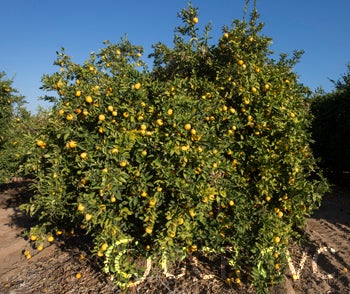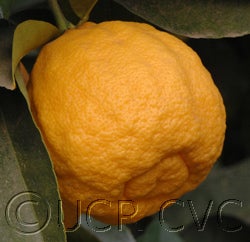Citrus jambhiri Lush. RUTACEAE
CRC 400
PI 539268
VI 76 (No longer available)
Source
Received as seed from Dr. Fawcett's #175. Seed rec'd from A. Melson, Florida, 1914.
Parentage/origins
Tree near Lake Okeechobee was source tree.
Rootstocks of accession
Carrizo citrange, C-35 citrange
Season of ripeness at Riverside
Some crop throughout the year but mainly in winter.
Description from The Citrus Industry Vol. 1 (1967)
"Fruit medium in size, of highly variable form but usually oblate to elliptic-oblong; commonly with irregularly furrowed or lobed basal collar or neck; usually with broad apical nipple surrounded by a deep irregular areolar furrow. Rind medium-thick; surface typically deeply pitted, and rough or bumpy, sometimes ribbed; easily separable; color lemon-yellow to brownish-orange. Segments about 10; axis large and hollow. Flesh color light yellow to pale orange; medium juicy; flavor moderately acid. Seeds numerous, small, highly polyembryonic, and cotyledons faintly green.
Tree vigorous and large, upright-spreading, with numerous small thorns; leaves medium-small, blunt-pointed, and light green. Flowers small and mandarin-like, purple-tinged, and produced more or less throughout year, but mainly in spring and late summer. New shoot growth faintly purple-tinted. Sensitivity to cold about like that of true lemons.
This species exhibits a remarkable range of variation in fruit characters, and in India, where it is native, four relatively distinct types are recognized, one of which is similar to the form obtained from Italy known as C. volckameriana (for description see Chapot, 1965a). There is also a sweet-fleshed form.
Presumably native to northeastern India, where it still grows wild, the rough lemon seems to have been taken to southeast Africa by the Portuguese toward the end of the fifteenth or early sixteenth century and thence to Europe. It doubtless reached the New World not long thereafter.
Although used to some extent as a lemon substitute, for which it is not very suitable, the rough lemon is highly important as a rootstock in many parts of the world—notably India, South Africa, Australia, Argentina, Brazil, and Florida. In the last two mentioned countries, selections have recently been named—Estes and Milam—which exhibit resistance to the burrowing nematode.
While resemblances to the lemon are fairly obvious, the differences are greater, and many of its characters are clearly those of the Rangpur or mandarin."
Availability
No longer commercially available in California. This accession no longer has an approved budsource. Please refer to the CCPP for information on another approved budsource or to start a reintroduction inquiry.
USDA Germplasm Resources Information Network page for Florida rough lemon


